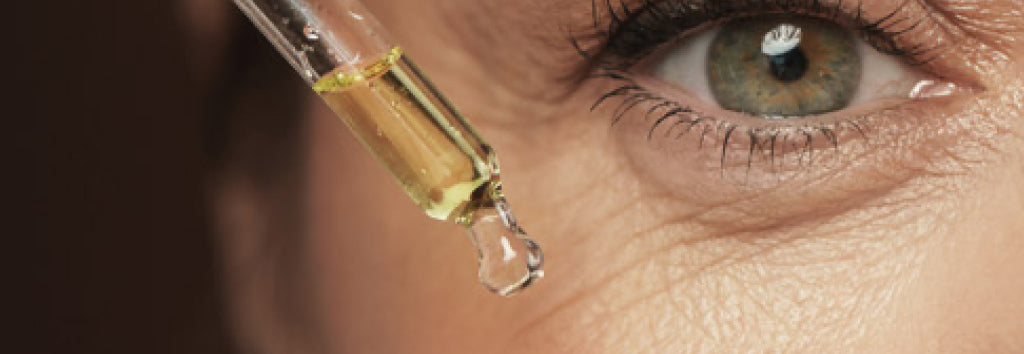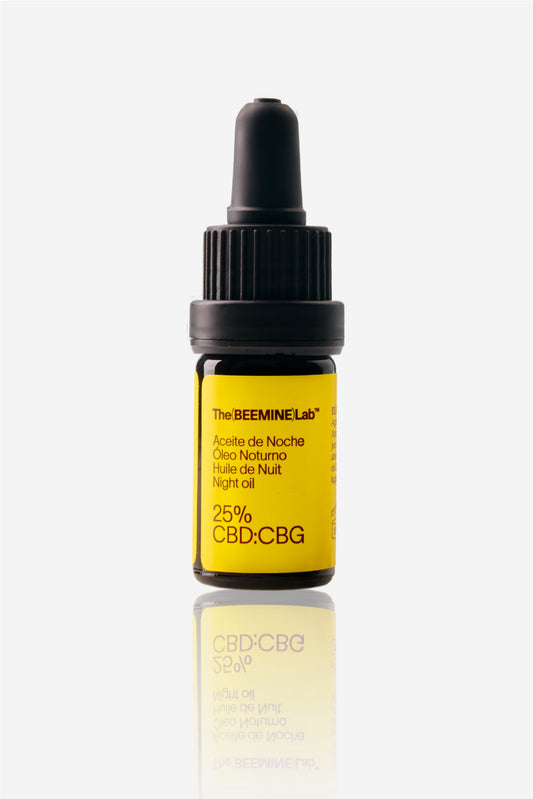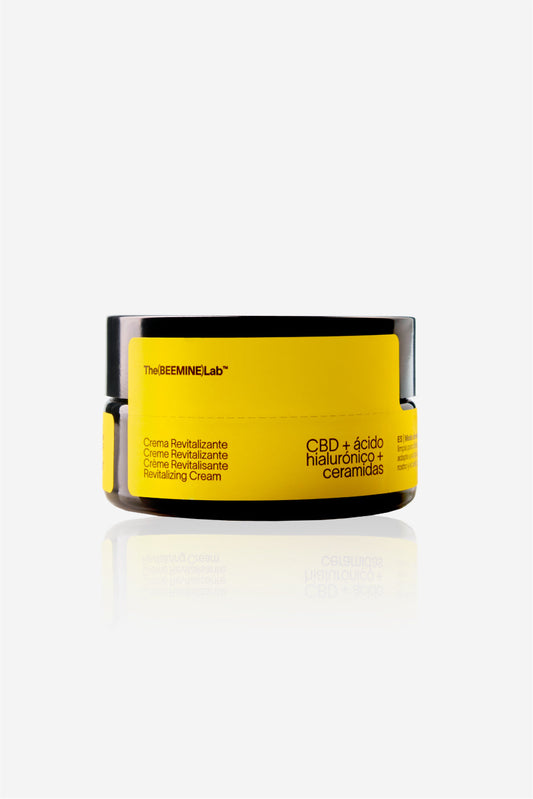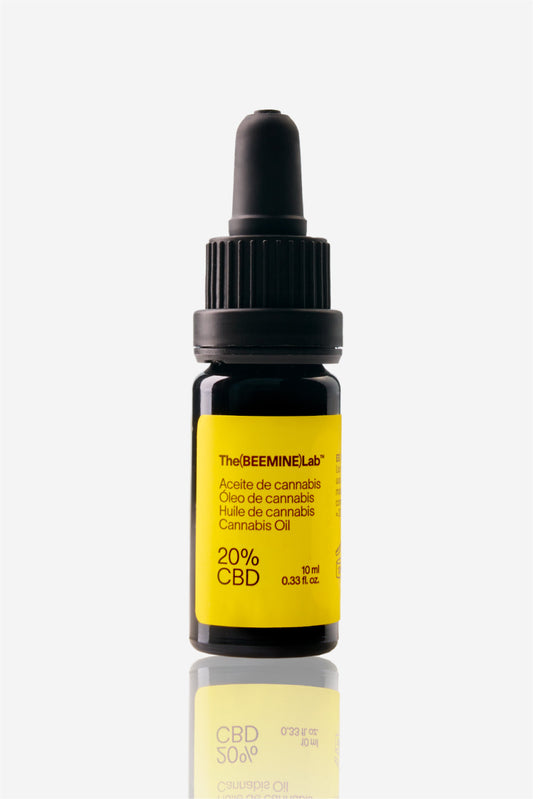The cosmetic uses of CBD ( cannabidiol ) have intensified in recent times and its benefits on the skin are quite striking , being a fairly safe active ingredient and, unlike THC (tetrahydrocannabinol), it does not have psychotropic or toxic effects. The skin has endocannabinoid receptors that are capable of interacting with CBD and triggering numerous processes that produce multiple benefits for treating and preventing skin conditions.
What is skin aging?
The skin is the largest organ in the human body, it covers the entire surface and its presence is extremely important since it is responsible for separating and protecting the internal part of our organism from the rest of the external environment.
Skin aging is defined as a continuous process in which
morphological and functional changes in the skin
occur progressively , which will have a characteristic and evident clinical presentation. These changes manifest themselves in multiple ways and affect each of the components or layers of the skin, from the epidermis to the subcutaneous tissue or hypodermis, without forgetting the appendages. (1)
Over time, the thickness of the skin decreases due to a change in the cellular content and the extracellular matrix in both the epidermis and the dermis. A series of epidermal changes occur
, which involve a decrease in the size and proliferation capacity of the keratinocytes of the stratum corneum and in the number of epidermal stem cells, which causes a progressive thinning of the epidermis. The number of active melanocytes also decreases, causing an uneven distribution of melanin in the skin and the consequent appearance of spots. The water content and lipid composition also decrease, so the skin's barrier function is altered and it tends to dry out more easily, becoming more rigid and more prone to flaking. The dermo-epidermal junction flattens , there are fewer papillae, which increases the skin's vulnerability and decreases nutritional exchange, which slows down the cell proliferation capacity.
The most difficult changes to alleviate occur at the level of the dermis . As there are fewer mast cells and fibroblasts, the amount of glycosaminoglycans and hyaluronic acid decreases, which causes disorganization and loss of collagen and calcification of elastin fibers, leading to the appearance of wrinkles, increased rigidity and loss of firmness and elasticity of the skin. (1)(2)
We can conclude by saying that skin ageing is a natural and inevitable process and represents a great challenge for aesthetic medicine and the world of cosmetics. By knowing the causes and factors that produce it, it could occur in a controlled and healthy way, since the key is to age well and not to prevent ageing.
Causes and factors that produce it
Skin aging is a multi-causal process and is driven by extrinsic and intrinsic factors. Intrinsic factors refer to processes that concern the body itself and are determined by our genes and skin type, and extrinsic factors relate to the environment and how it influences our skin from the moment we are born until we die, the latter being known as the exposome . (3)
-
Intrinsic factors:
-
Skin tone : Dark skin has greater protection against solar radiation, so signs of aging are less noticeable than in light skin, which has a higher risk of developing skin cancer.
-
Anatomy : Not all body parts age the same way due to differences in skin thickness and composition.
-
Hormones : The skin is sensitive to hormonal changes, especially during menopause.
-
Extrinsic factors: Most skin aging is due to these types of factors, and there is good news: they can be prevented.
-
Solar radiation : UVA radiation is the main cause of photoaging as it promotes the formation of free radicals and the consequent appearance of wrinkles and loss of skin firmness.
-
Tobacco : Smoking affects collagen and elastin fibers, decreases blood flow and therefore the transport of oxygen and nutrients to the tissues, causes oxidative stress that damages skin cells and promotes the appearance of spots.
-
Diet : Food influences the skin. A diet rich in antioxidants delays the appearance of wrinkles, while a diet rich in carbohydrates and fats promotes them.
-
Stress : Being stressed influences the appearance of the skin, affects the barrier function and makes it more vulnerable and more prone to developing pathologies such as dermatitis, acne or psoriasis. You can consult our article on CBD and stress here.
-
Lack of sleep : Lack of sleep is associated with a tired appearance, with the appearance of dark circles and fine expression lines.
-
Pollution : Exposure to polluting particles promotes the appearance of premature wrinkles and spots.
Benefits of CBD on skin aging. Scientific evidence
Excellent antioxidant
Antioxidants are chemical substances that are responsible for preventing or reducing the formation of free radicals or reactive oxygen species (ROS), which are formed as a result of metabolic reactions in our body or by exposure to environmental factors.  The overproduction of free radicals leads to oxidative stress, which is related to premature aging of the skin, because they attack collagen and elastin fibers and cause the appearance of wrinkles and expression lines as well as a loss of firmness in the skin.
Cannabidiol (CBD) has been shown to have a powerful antioxidant effect when applied topically, preventing and attenuating the signs of skin aging. It acts through two main mechanisms: preventing the formation of free radicals or ROS and modulating oxidative stress . Its functions include interrupting radical reactions, capturing ROS or transforming them into less active forms thanks to its molecular structure that contains two phenolic groups. It also reduces the formation of these ROS by chelating the transition metal ions involved in the production of these molecules.
On the other hand, it acts indirectly by activating the Nrf2 factor related to the transcription of antioxidant genes, supports the action of antioxidant enzymes and maintains the correct levels of glutathione (GSH) necessary to support the antioxidant action of vitamins A, C and E due to its ability to reduce ROS. Finally, it acts on different types of receptors , which directly regulate the expression of antioxidant enzymes such as endocannabinoid receptors (CB1 and CB2) as well as ionotropic (TRP) and nuclear (PPAR) receptors. (4)(5)(6)
The overproduction of free radicals leads to oxidative stress, which is related to premature aging of the skin, because they attack collagen and elastin fibers and cause the appearance of wrinkles and expression lines as well as a loss of firmness in the skin.
Cannabidiol (CBD) has been shown to have a powerful antioxidant effect when applied topically, preventing and attenuating the signs of skin aging. It acts through two main mechanisms: preventing the formation of free radicals or ROS and modulating oxidative stress . Its functions include interrupting radical reactions, capturing ROS or transforming them into less active forms thanks to its molecular structure that contains two phenolic groups. It also reduces the formation of these ROS by chelating the transition metal ions involved in the production of these molecules.
On the other hand, it acts indirectly by activating the Nrf2 factor related to the transcription of antioxidant genes, supports the action of antioxidant enzymes and maintains the correct levels of glutathione (GSH) necessary to support the antioxidant action of vitamins A, C and E due to its ability to reduce ROS. Finally, it acts on different types of receptors , which directly regulate the expression of antioxidant enzymes such as endocannabinoid receptors (CB1 and CB2) as well as ionotropic (TRP) and nuclear (PPAR) receptors. (4)(5)(6)
Great moisturizing power
Another of the great benefits of this active ingredient is its moisturizing action . CBD administered topically is able to interact with the sebaceous glands of the skin and regulate the production of sebum at this level. In such a way that in those areas of the skin where there is greater dryness, its secretion will increase, and in skins with a greater amount of fat, it will decrease. In addition, hemp seed oil or CBD is rich in fatty acids , omega 3 ( 3 to 40 times higher than that found in argan or coconut oils), Omega 6 and Omega 9, so this active ingredient will favor the skin's barrier function by keeping the hydrolipidic mantle in good condition and forming a kind of film on the skin that will thus prevent transepidermal water loss, being especially effective on dry skin and atopic dermatitis, which tend to flake and develop wrinkles and expression lines easily. (7)(8)
Antidepressant action and anti-stress effect
Stress and depression
have been shown to accelerate the
skin aging process . Any alteration in our normal psychological state such as mood disorders, stress, anxiety or depression can lead to alterations in our skin. The most common symptoms of stressed skin are a lack of luminosity and dull tone , clogged pores , dehydration , redness and annoying itching when exposed to strong emotional or temperature changes, and often pimples and acne breakouts . All of these conditions contribute to the skin having an aged and dull appearance, so it is very important to prevent them or keep them under control.
Cannabidiol (CBD) is capable of balancing the hypothalamus-pituitary-adrenal axis of the stress response and also has antidepressant and anxiolytic effects .
This happens thanks to a physiological system present in our body called the endocannabinoid system (ECS), which is responsible for balancing our body and plays an important role in regulating the mechanisms of stress and depression . CBD consumed in the form of oil and sublingually is able to interact with endocannabinoid receptors such as CB1 and CB2 or 5-HT1a receptors ,
helping to regulate serotonin and dopamine levels to promote emotional stability. In addition, this active ingredient regulates the production of hormones that participate in the response to stress such as cortisol at the level of the hypothalamus, pituitary gland and adrenal glands, reducing its peaks and thus protecting tissues from damage induced by this hormone. (9)(10)(11)
Reduces inflammation and has a calming effect
Some skin disorders such as atopic dermatitis (AD) , psoriasis , rosacea , reactive and sensitive skin are triggers for premature aging . Although the pathogenesis of all of them is not very clear, it is known that one of the main symptoms of this type of skin is inflammation and irritation , among many others.
One of the great benefits of Cannabidiol (CBD) on the skin is its anti-inflammatory action. This is due to the endocannabinoid system (ECS) found in our skin and which has many receptors that respond to CBD such as the metabotropic receptors (CB1R and CB2R) mainly, which play a fundamental role in suppressing skin inflammation and providing a calming effect. On the other hand, it is important to highlight that in many cases these types of conditions have an emotional origin, so the anxiolytic and antidepressant benefits of CBD have been shown to play a fundamental role in the outbreaks and progression of these conditions. (4)(10)(12)
Sleep better with CBD
The quality of sleep influences the appearance and aging of the skin . It has been shown that sleeping at least 7-8 hours is essential not only for the correct functioning of our body, but also to prevent the signs of aging. During the night, the skin undergoes a process of cellular regeneration , dead cells are shed and allow the skin to continuously renew itself. In addition, metabolic processes such as
skin thermoregulation and the release of hormones such as melatonin and cortisol occur, which are the ones that have the greatest impact on dermatological processes.
Lack of sleep causes accelerated skin aging , as it produces an alteration in the skin's barrier function, causing a worse response to external agents. It is also associated with a reactivation of dermal conditions associated with stress such as atopic dermatitis and acne, due to an imbalance in the release of hormones involved in this process. In addition, there is a decrease in skin luminosity , since when we sleep little or poorly, noradrenaline is released , a hormone that reduces blood circulation and consequently, oxygenation and the supply of nutrients to the skin , which looks dehydrated and neglected.
Sleep-wake cycles are regulated by the endocannabinoid system (ECS) . CBD administered sublingually is able to interact with endocannabinoid receptors and contributes to improving sleep quality , reducing both insomnia and hypersomnolence . In addition, as mentioned above, cannabidiol reduces stress and anxiety , so it will help you fall asleep and stay asleep. (10)(11)(13)
How can I use CBD and introduce it into my skincare routine?
The most common topical presentation of CBD is in the form of creams and balms . They have a denser texture, although they can be presented in a more fluid format. These formulas are usually accompanied by other active ingredients to improve hydration and provide greater nutrition, such as emollient agents (butters, waxes, oils, honey, etc.) and moisturizers (hyaluronic acid, thermal water, etc.).
Antioxidant agents are also often added (vitamin A, vitamin E, honey, oils, etc.).
It is important to remember that CBD is absorbed through the skin, exerting a local effect, but it does not reach the bloodstream and therefore does not reach the central nervous system. In addition, this active ingredient does not have psychotropic or psychoactive effects, so it is very safe when applied topically.
At The BeeMine Lab we offer a range of skin care products for all skin types. Depending on what you want to achieve and your skin type, you can use one product or another: our CBD moisturising cream is ideal for relieving sensitive skin and providing greater hydration and nutrition to dry skin . Due to its sebum-regulating effect, it is also effective for acne-prone skin, reducing the inflammation associated with acne and providing optimal hydration at the same time. The CBD revitalising cream has very good effects on blurring expression lines and improving skin luminosity . Both creams can be used day and night independently, or in
combination , preferably applying the moisturising cream in the morning, to avoid the effects of pollution and solar radiation, and the revitalising cream at night to reduce and prevent signs of ageing. For the lips, you can use our CBD lip balm , to provide greater hydration and intense repair. As a complement to our facial routine, we can apply the HANI+ facial mask 1-2 times a week to repair and provide extra nutrition to our skin.
For the body, we can apply the CBD and honey body lotion day and night to maintain optimal hydration of our skin and prevent aging.
Cosmetic oils have a very fluid texture and are ideal for dry or flaky skin. They are usually more concentrated and should be applied in small quantities to achieve the desired effect.
In this case, we have our basic 3% CBD oil
, which is applied topically once or twice a week as a serum. This oil is ideal for having a sebum-regulating and anti-inflammatory effect on the skin and treating conditions such as acne, atopic dermatitis, and rosacea. It also has a calming and moisturizing effect on the skin, making it especially beneficial for dry and sensitive skin that is very prone to premature aging. It can be applied independently or combined that day with our moisturizing cream, applying the cream first and then the oil.
]
Bibliography
-
Lozada, SM and Ricardo, R. (2010). Skin aging. Rev Asoc Colomb Dermatol. 18 , 10-17.
- https://www.elsevier.es/es-revista-farmacia-profesional-3-articulo-envejecimiento-cutaneo-1310039
-
Ruiz Martínez, MA and Morales Hernández, ME(2015). Approach to the Treatment of Skin Aging. Ars Pharm.,56 (4) , 183-191.
-
Yarar, E. and Bagar, T. (2022). The role of CBD in Anti-aging and Longevity. Canna Foundation
- https://www.cannabeta.eu/es/2020/04/09/proprieta-antiossidanti-e-antinfiammatorie-del-cannabidiolo-e-dei-suoi-derivati/
- Pellati, F.; Borgonetti,V.; Brighenti,V.; Biagi,M.; Benvenuti, S.; Corsi,L.; Cannabis sativa L. and Non psychoactive Cannabinoids: Their Chemistry and Role against Oxidative Stress, In?ammation and Cancer, Biomed. Res. Int. 2018, 2018.
-
Mounessa, Jessica S. et al. “The role of cannabinoids in dermatology” . Journal of the American Academy of Dermatology , 77(1), 188 – 190
-
Sheriff, Tabrez & Lin, Matthew & Dubin, Danielle & Khorasani, Hooman. (2019). The potential role of cannabinoids in dermatology. Journal of Dermatological Treatment , 10 , 1-7.1080/09546634.2019.1675854.
-
Feingold, D., & Weinstein, A. (2021). Cannabis and Depression. Advances in experimental medicine and biology , 1264 , 67–80.
-
Sallaberry, C. A., & Astern, L. (2018). The Endocannabinoid System, Our Universal Regulator. Journal of Young Investigators , 34 .
-
Bih, CI; Chen, T.; Nunn, AVW; Bazelot, M.; Dallas, M.; Whalley, B.J. (2015). Molecular targets of cannabidiol in neurological disorders . Neurotherapeutics , 21 (23), 699-730.
-
Muñoz, E. Cannabinoids and Inflammatory Skin Diseases. Canna Foundation
-
Shannon, S., Lewis, N., Lee, H., & Hughes, S. (2019). Cannabidiol in Anxiety and Sleep: A Large Case Series. The Permanent journal , 23 , 18–041.
 The overproduction of free radicals leads to oxidative stress, which is related to premature aging of the skin, because they attack collagen and elastin fibers and cause the appearance of wrinkles and expression lines as well as a loss of firmness in the skin.
Cannabidiol (CBD) has been shown to have a powerful antioxidant effect when applied topically, preventing and attenuating the signs of skin aging. It acts through two main mechanisms: preventing the formation of free radicals or ROS and modulating oxidative stress . Its functions include interrupting radical reactions, capturing ROS or transforming them into less active forms thanks to its molecular structure that contains two phenolic groups. It also reduces the formation of these ROS by chelating the transition metal ions involved in the production of these molecules.
On the other hand, it acts indirectly by activating the Nrf2 factor related to the transcription of antioxidant genes, supports the action of antioxidant enzymes and maintains the correct levels of glutathione (GSH) necessary to support the antioxidant action of vitamins A, C and E due to its ability to reduce ROS. Finally, it acts on different types of receptors , which directly regulate the expression of antioxidant enzymes such as endocannabinoid receptors (CB1 and CB2) as well as ionotropic (TRP) and nuclear (PPAR) receptors. (4)(5)(6)
The overproduction of free radicals leads to oxidative stress, which is related to premature aging of the skin, because they attack collagen and elastin fibers and cause the appearance of wrinkles and expression lines as well as a loss of firmness in the skin.
Cannabidiol (CBD) has been shown to have a powerful antioxidant effect when applied topically, preventing and attenuating the signs of skin aging. It acts through two main mechanisms: preventing the formation of free radicals or ROS and modulating oxidative stress . Its functions include interrupting radical reactions, capturing ROS or transforming them into less active forms thanks to its molecular structure that contains two phenolic groups. It also reduces the formation of these ROS by chelating the transition metal ions involved in the production of these molecules.
On the other hand, it acts indirectly by activating the Nrf2 factor related to the transcription of antioxidant genes, supports the action of antioxidant enzymes and maintains the correct levels of glutathione (GSH) necessary to support the antioxidant action of vitamins A, C and E due to its ability to reduce ROS. Finally, it acts on different types of receptors , which directly regulate the expression of antioxidant enzymes such as endocannabinoid receptors (CB1 and CB2) as well as ionotropic (TRP) and nuclear (PPAR) receptors. (4)(5)(6)







